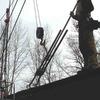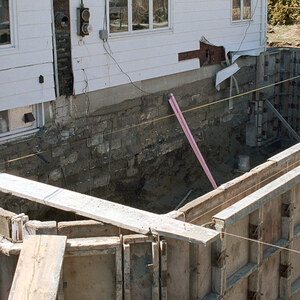I’ve used both types of machines, and they each have their place. If you’re just sanding some old finish off of floors in decent shape, the orbital type will work fine. If you have to take off some serious wood, the drum sanders will go much faster.
Drum sanders take more skill to get the floor flat, and it’s important to practice on a sheet of plywood or in an unimportant area first. They’re very aggresive, so if you set them down and pick them up too fast, you’ll make grooves and waves in the floor.
Minwax makes a lot of different colors of wood filler, you might want to try some of them. It’s best to test the filler with the finish over it before you commit to something.
I find that it’s hard to locate all the holes in a floor until it’s sanded, so I sand the floor, vacuum it, fill it, then spot sand with a palm sander on the filler. I vaccum again, and then clean the floor with a rag with a little paint-thinner on it (I use oil based finishes, don’t try that with a water based).
zak
“so it goes”



















Replies
thanks for the reply zak. i've just installed new t&g oak floors and have some over-wood in areas and some uneveness throughout; I used a 6in. orbital with 25grit in the closet but it definitely takes alot of time, are the orbital machines more aggresive? faster revolutions etc?
The big random orbit sanders are not very aggresive, but they'll definitely go faster than a hand held sander. If you use a coarse sandpaper, (especially on a hard wood), you have to be very careful to sand through all the finer grits and get out the curlycues that the 36 grit puts in. (ask me how I know).
With a drum sander, I do a herringbone pattern with the coarse sandpaper, about 30 degrees to the length of the boards. That flattens the floor a lot, and then I finish with a pattern parallel to the boards.
I don't know how many high spots you have, but you could knock off the high spots with a handheld belt sander or a sanding disk on a 4.5" grinder, and then use the random orbital floor sander.zak
"so it goes"
Zak,
When using the drum sander do you start out with 36 grit? If I choose to use the orbital should it be 36-100 grit? would a herring bone pattern work with the orbital? I've used the drum sander to flatten out the spruce plank sub-floor. It worked great but then I had to rent the edger to get close to the wall and a fein tool to get into the corners. it seemed to take forever. I know that a drum can really ruin the floor if not careful and the orbital can get close to the walls but will the orbital be enough to flatten to satisfaction. How flat should the floor be?
I'll be using a minwax oil-based clonial maple stain on the floor. You mentioned min-wax fillers. does this stuff match the stain? Do I apply it after using 36 grit and sand it with 40? or the same? should 2 applications of filler be considered or is it over-kill.
I plan on applying an industrial grade poly (6fd100), in semi-gloss, a product from Velvit Products Co. often used on wood gymnasium floors. Longer drying time but it seems pretty durable, any tips on applications of stains and poly? I really appreciate the feedback. Thanks Again.
I usually start with 36 grit, but that's for floors that have been covered in linoleum, and need a lot of help. I recommend starting with a finer sandpaper to see how that does, and then go to a coarse sandpaper if it seems necessary.
The pattern you do with the orbital won't matter a whole lot, since it's not directional, and a lot more sandpaper is touching at once. The main thing is to try for even coverage, so you don't make any dips or swales. The orbital will flatten the floor some, I can't tell you if it will be enough or not. Rent one and find out, I guess- 4 hours of rental should only cost $30 or so, and sandpaper is returnable.
As for wood fillers, I usually do the filling after I'm done sanding to 120 grit, and done with the big sanders. Then I vacuum the floor, fill, and sand the filled spots with a palm sander. I don't know how well the minwax filler matches- you'll really have to try it out with your combination of stains and finishes.
The important things when applying the finish are to have the area really clean, and apply a nice, even coat. I use a lambswool applicator or a fleecy-pad painter.zak
"so it goes"